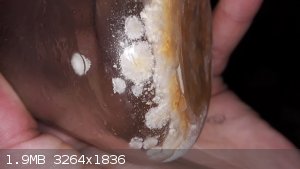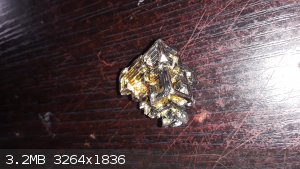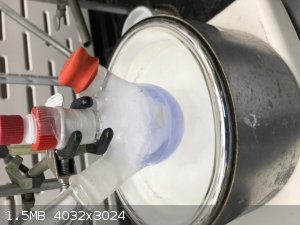Tkuze
Hazard to Others
  
Posts: 108
Registered: 8-5-2019
Member Is Offline
|
|
Does anyone have a prefered method for synthesis of acetaldehyde?
I'm familiar with several methods to synthesize acetaldehyde, but each has its downside. Can anyone offer their prefered method and some insight into
the results and procedure? Thanks

|
|
|
Assured Fish
Hazard to Others
  
Posts: 319
Registered: 31-8-2015
Location: Noo Z Land
Member Is Offline
Mood: Misanthropic
|
|
Well, what methods have you personally tried?
I unfortunately have only tried a few ways that don't work so great, like oxidation of ethanol using hypochlorite or dichromate, or trying to
dehydrogenate ethanol with copper metal in a very crude apparatus (this method needs work on my part).
I know of a method that nobody has tried yet which involves oxidation of ethanol with H2O2 and a catalytic amount of bismuth tribromide.
This might work well as the reaction proceeds at 70*C so the distillate could be directly caught in dilute ammonia.
Is that the ammonia trimer you have there? If so then it looks like you have managed to get together a reasonable amount, do you know what the
discoloration is?
Sufficiently advanced science is indistinguishable from madness.
|
|
|
rockyit98
Hazard to Others
  
Posts: 283
Registered: 12-4-2019
Location: The Known Universe
Member Is Offline
Mood: no mood is a good mood
|
|
acetylene hydration using HgSO4 and H2SO4
HC≡CH + H2O + HgSO4 & H2SO4 ——> [ H2C=CHOH ] ——> H3C-CH=O
|
|
|
unionised
International Hazard
    
Posts: 5102
Registered: 1-11-2003
Location: UK
Member Is Offline
Mood: No Mood
|
|
"Does anyone have a prefered method for synthesis of acetaldehyde?"
Over the years I have synthesised a lot of acetaldehyde by enzymatic oxidation of ethanol- typically on Friday nights.
It's my favourite method but it's impractical to extract the product.
|
|
|
clearly_not_atara
International Hazard
    
Posts: 2691
Registered: 3-11-2013
Member Is Offline
Mood: Big
|
|
It’s not really synthesizing acetaldehyde that’s hard, it’s capturing and purifying it. It has a low bp, a strong odor, and it polymerizes
easily. Inconvenient, to say the least.
[Edited on 04-20-1969 by clearly_not_atara]
|
|
|
Tkuze
Hazard to Others
  
Posts: 108
Registered: 8-5-2019
Member Is Offline
|
|
Thanks for the imput. The bismuth tribromide seems very interesting. For some reason that picture was accidentally included when I posted this topic.
It does seem that making the timer is the most stable way, as you can store it and depolymerize it on demand.
|
|
|
Assured Fish
Hazard to Others
  
Posts: 319
Registered: 31-8-2015
Location: Noo Z Land
Member Is Offline
Mood: Misanthropic
|
|
http://www.sciencemadness.org/talk/viewthread.php?tid=55&...
8th post up from the bottom, you will find the bismuth tribromide reference there.
Sufficiently advanced science is indistinguishable from madness.
|
|
|
karlos³
International Hazard
    
Posts: 1520
Registered: 10-1-2011
Location: yes!
Member Is Offline
Mood: oxazolidinic 8)
|
|
So far, I have only used the dichromate oxidation of ethanol.
That works fine and is easy, yields are ok as well.
Works for my purpose.
But since I have some ethyl iodide, I want to try the sommelet reaction on it using hexamine too.
Found a paper on that and it seems feasible, first they form the adduct in chloroform just like it is done in the delepine reaction, and then the
isolated adduct is hydrolysed with acid.
I am planning to isolate the acetaldehyde by distilling it off directly from the reaction mixture.
I must admit, that for general purposes I rather buy it, while preparing it myself is just for fun.
|
|
|
Tkuze
Hazard to Others
  
Posts: 108
Registered: 8-5-2019
Member Is Offline
|
|
Assured fish: thanks so much for the link.
Karlos: would you be willing to share your notes in a private message or email? Also, I have not been able to find a commercial source of ethanal.
Could you share the source?
Any other imput or procedures/notes would be very helpful to me! Thanks
Heres a picture of german lab grown bismuth from my element collection for fun!
Let me know if I can offer any advice or help for your research in exchange for your advice.

|
|
|
VSEPR_VOID
National Hazard
   
Posts: 719
Registered: 1-9-2017
Member Is Offline
Mood: Fullerenes
|
|
Copper wire and acetone, its a classic
If you were to do this in a proper reaction vessel with a reflux condenser and inert atmosphere it may work
https://www.youtube.com/watch?v=KBy_cjnMjpo
I think you can also use acidified dichromate for this as well
Within cells interlinked
Within cells interlinked
Within cells interlinked
|
|
|
Tkuze
Hazard to Others
  
Posts: 108
Registered: 8-5-2019
Member Is Offline
|
|
Thanks. Using the copper cat. Is the reaction im trying to avoid, but I may end up having to do it.
|
|
|
DrScrabs
Hazard to Others
  
Posts: 123
Registered: 13-3-2018
Location: Laputa
Member Is Offline
Mood: Still evaporating..
|
|
There can be side products like dimethyl mercury (I read somewhere I don´t remember but the possibility is enough to not do it).
I like the method using fenton´s reagent if I can get H2O2 cheap. The FeSo4 can be present in low concentrations and produces no heavy metal waste.
The high acetic acid "side product" may be a downside but I neutralized it as the sodium salt, purified by recrystallisation and store it for further
use. It was a fun project anyway.
The following is from my self written data book. All I write down for me is not fulltext style as I tend to shorten text, so I give no guerantee but I
try to post it as accurate as I can.
Acetaldehyde - Ammonia trimer preparation [The practical methods of organic chemistry, by C. Gattermann, 135, 1909]
Bubble dry ammonia through a etheral soloution of acetaldehyde until the liquid is saturated. Filter the precipitate after an hour or more(cool on a
salt ice bath). Wash the filtrate with ice cold ether.
Back to acetaldehyde:
dissolve 10g of the trimer in 10ml of water, treat it with 15 ml of cold H2So4 and 20ml of water and distill the fraction coming over at 21°C.
Paraldehyde preparation [Organinc medical chemicals, by M. Barowliff 15-16, 1921]
500g of acetaldehyde are placed in a round bottom flask with mechanical stirring and an efficient reflux condenser. 1ml of conc. HCl (d=1.18) is
added. The polymerization reaction begins depending of the initial tremperature and a vigorous reaction sets in. The acetaldehyde begins to boils and
begins to reflux. On slowdown 1ml of HCl is added and this procedure is repeated until no further heat is evolved. when the maximum degree of
polymerization is reached the reaction mixture is neutralized with aqueous NaHCO3 soloution. To obtain pure paraldehyde, the reaction mixture is
fractionally destillied with a very efficient column. Unchanged acetaldehyde passes over first, then the fraction wich consits of a mixture of
acetaldehyde and paraldehyde*. The fraction distilliling at 123-125°C consists of pure paraldehyde yielding a colourless mobile liquid.
Paraldehyde melts at 10°C. Depolymerization with 0.5ml conc. H2SO4 for 50ml paraldehyde.
* paraldehyde : acetaldehyde 46.6 : 53.4% constant boiling mixture @ 42°C , unkown source
[Edited on 3-7-2019 by DrScrabs]
|
|
|
Tkuze
Hazard to Others
  
Posts: 108
Registered: 8-5-2019
Member Is Offline
|
|
Thanks! I will incorporate this. I really appreciate your help. This is probably the more important part of the procedure because it allows the
careful storage of the product.
|
|
|
Tkuze
Hazard to Others
  
Posts: 108
Registered: 8-5-2019
Member Is Offline
|
|
I ordered ferrous sulfate heptahydrate(couldnt find anhydrous), potassium dichromate, and potassium dichromate. Does anyone know the best way to make
the ferrous sulfate anhydrous without oxidizing it to pesky Fe(III) species? Or is it even neccesary since i will be using an aqueous solution of 40%
H202 in ethanol in a 14/20 distillation setup?
|
|
|
DrScrabs
Hazard to Others
  
Posts: 123
Registered: 13-3-2018
Location: Laputa
Member Is Offline
Mood: Still evaporating..
|
|
You answered your question on your own, use the hydrate.
Be careful as the reaction tends to runaway.
Fenton's oxidation of ethanol to ethanal part 1:
https://www.youtube.com/watch?v=yYOhNQaWLt8
|
|
|
Tkuze
Hazard to Others
  
Posts: 108
Registered: 8-5-2019
Member Is Offline
|
|
Thanks DrScrabs! This was the video I settled upon as my plan for the reaction i will carry out. Since we independently came to the same conclusion,
then its a game plan. Thanks
|
|
|
DrScrabs
Hazard to Others
  
Posts: 123
Registered: 13-3-2018
Location: Laputa
Member Is Offline
Mood: Still evaporating..
|
|
Great, I am really interested in your results!
Take care of the H2O2 concentration you want use. In the video he uses 20vol (6%) H2O2 if I understood it right. I used 10% but better start at 6% to
get a feeling for the reaction.
If you use your 40% H2O2 you will probably have a rocket.
|
|
|
Tkuze
Hazard to Others
  
Posts: 108
Registered: 8-5-2019
Member Is Offline
|
|
Wow! Thanks for the head up. I will carefully document the procedure and post here probably next week when my reagents arrive.
|
|
|
j_sum1
Administrator
       
Posts: 6218
Registered: 4-10-2014
Location: Unmoved
Member Is Offline
Mood: Organised
|
|
Make sure you check out the sticky on acetaldehyde. Lots of good stuff in there, including some recently-posted references to H2O2 oxidation of
ethanol.
https://www.sciencemadness.org/whisper/viewthread.php?tid=55...
and
https://www.sciencemadness.org/whisper/viewthread.php?tid=55...
|
|
|
Tkuze
Hazard to Others
  
Posts: 108
Registered: 8-5-2019
Member Is Offline
|
|
I found a few exact procedures from your link wirh exactly what I need. I CAN'T thank you enough!
|
|
|
markx
National Hazard
   
Posts: 645
Registered: 7-8-2003
Location: Northern kingdom
Member Is Offline
Mood: Very Jolly
|
|
Ozonation of ethyl alcohol also yields acetaldehyde....just a curious discovery I made while playing around with ozone generation process. Probably
not too good of a method for generating bulk quantities, but as a sidenote it is perhaps an interesting piece of trivia.
Exact science is a figment of imagination.......
|
|
|
Tkuze
Hazard to Others
  
Posts: 108
Registered: 8-5-2019
Member Is Offline
|
|
Really? Interesting. One would think of undergrad orgo and forsure 2-butene would yield acetaldehyde. Can you elaborate on the mechanism and
experimental?
|
|
|
Tkuze
Hazard to Others
  
Posts: 108
Registered: 8-5-2019
Member Is Offline
|
|
Picture of ozonolysis
Ozonolysis of an oxysterol derivative in MeOH followed by NaBH4 reduction

|
|
|
Tkuze
Hazard to Others
  
Posts: 108
Registered: 8-5-2019
Member Is Offline
|
|
Interesting ozonide mechanism
Markx- thanks for the comment. I found this to be an interesting read. It might serve as a good way to make an alcoholic acetaldehyde solution, which
you could add water to and store for long periods with good stability similar to 37% formaldehyde solutions.
https://www.google.com/url?sa=t&source=web&rct=j&...
|
|
|